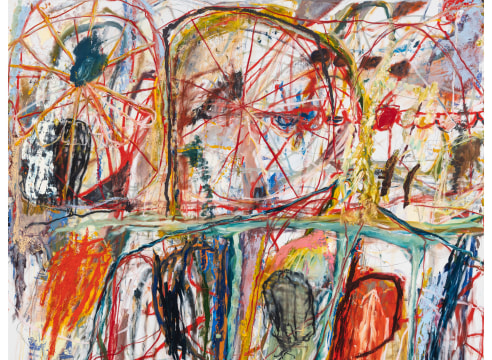
Fredericks & Freiser is pleased to announce Frying Pan Country, the first solo exhibition of Sam Mattax. The artist creates abstract canvases with an archaeological layering of paint, emotion, sign, line, color, and bare canvas itself. He leaves rough expanses of primed heavy weight canvas exposed, imparting a sense of gritty multidimensionality that denies a slick, polished formalism. Rather than glossing and glazing over the canvas in a painterly sugar rush, Mattax’s work incorporates the physicality of the support itself as a medium, lending his monumental paintings a sculptural sense of structural integrity. Gobs of paint, squeezed from the ends of oil paint sticks and thrown at the canvas, take this paradox to its logical conclusion: paint itself becomes sculpture. Mattax’s masterful use of color presents the viewer with attractive pastels as seductive lines of entry into the work but denies the simple pleasures that these pop-inspired colors promise. Indeed, Mattax’s uses of color, line, and compositional space can induce, by turns, frustration, devastation, empowerment, loss, love, and ultimately, hope.
The powerful nature of Mattax’s work reckons with a visual culture dominated by a demand for instantaneous gratification. Cutting through today’s dopamine hits of zombie scrolling and glib therapy-speak, he insists on both generating meaning and rendering it opaque. Not everything in the world of these works is open to easy explanation and categorization: though these paintings offer an open network, allowing the viewer to see through all the many layers of mark-making, there remain moments of densely painted canvas that resist transparency. These thick moments sit like a lump in the painting’s throat, a call to the expressive capacity of painting to communicate when words fail. Refusing any tendency toward black-and-white thinking, Mattax’s paintings leverage abstraction as a way to work through the messier aspects of the human experience and insist on sometimes allowing areas of that experience to remain mute and inscrutable.
By embracing the complicated interweaving of paint, canvas, and emotional time, Mattax builds upon a deep history of abstraction and a multidisciplinary approach to artmaking. His use of oil paint in service of drawing and linework calls to mind Cy Twombly’s transcendent canvases or Philip Guston’s tightrope walk between figuration and abstraction. But Mattax’s repetitive motifs, such as spoked wheels, push Twombly’s gentle lyricism and Guston’s ironic figures further towards a dynamic system of signs with no fixed meaning or predetermined inner harmony. The balance within these works and the significance of each individual symbol emerges only from the overall context of each composition. Color and line work together in an homage to Joan Mitchell’s emotional expressivity. This delicate formal relationship sometimes produces surprising results, however blood reds become calming and stable, delicate pinks fleshy and disquieting, and royal blues and dark blacks searingly energetic.